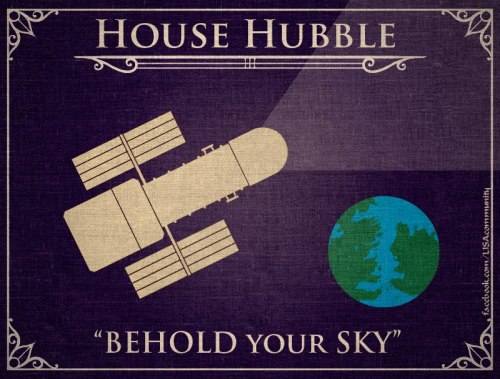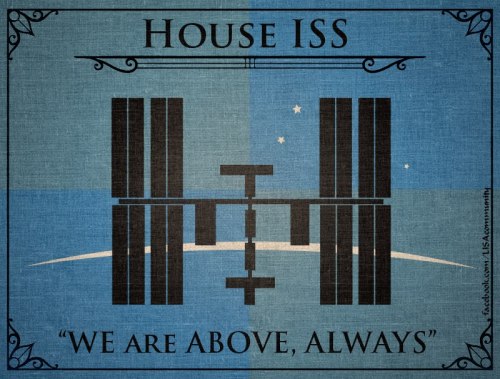SCIENCE IS COMING.









SCIENCE IS COMING.
In honor of the release of Game of Thrones Season 6 today, check out these amazing House designs made by students from the Albert Einstein Institute. Each Game of Thrones inspired sigil celebrates a different changing project in physics and space exploration.
House Hubble - Hubble Space Telescope
House ISS - International Space Station
House ITER - Nuclear Fusion Project
House LHC - Large Hadron Collider
House Curiosity - Mars Science Laboratory
House LISA - Laser Interferometer Space Antenna
House JWST - James Webb Space Telescope
House VLA - Very Large Array
I’m super torn because while I’m #teamradioforever, I’m also a lifelong #hubblehugger. I guess if I’m forced to chose, it might have to be House VLA.
- Summer
[HT Charee Peters]
More Posts from Thebryanscout and Others




Rockhound, with the Tampax in Taipei.
Mr. Sandman... Bring me a meme. Make it the dankest, that I've ever seen...

The Big Bang Theory Merchandise: http://bit.ly/1aAdDNX
Mankind is advanced technically. Man can build space stations, can assemble them in space, and ponders about landing on Mars, but the development of mankind itself seems to stagnate on stone age level.
Sigmund Jähn, the first German cosmonaut
Jherek Bischoff, Amanda Palmer, and Neil Gaiman cover David Bowie’s “Space Oddity” on the marvelous orchestral tribute EP, Strung Out In Heaven (learn more). Artwork by Sarah Beetson.
Bischoff also composed this beautiful instrumental rendition of “Life On Mars?” (artwork by Félix Marqués)
Strung Out In Heaven: A Bowie String Quartet Tribute by Jherek Bischoff





A genius named Eleanor Lutz made a beautiful map of one interesting slice of Mars (based on this USGS map). She says:
Recently I’ve been really into old maps made by medieval explorers. I thought it would be fun to use their historical design style to illustrate our current adventures into unexplored territory. So here’s my hand-drawn topographic map of Mars, complete with official landmark names and rover landing sites.
Not only is it beautiful to look out - it’s fun to explore. I never new that Mars’ small craters are officially named after small earth towns - here, Lutz labels them and (in caps) indicates their home country on earth. The large craters bear the names of famous scientists.
I highly recommend heading over to http://tabletopwhale.com/ to check out the higher resolution version.

The “Spider” during testing on the Apollo 9 mission.
In Defense of Holden Caulfield
I honestly don’t know if I’ll ever understand why exactly people hate Holden Caulfield from “The Catcher in the Rye”.
I mean, sure, you could defend your dislike with a classic gem such as, “Oh, he’s just a whiny, pretentious f***boy! He’s so boring, all he does is complain!”
But at that I’m just like
okay, wow, I’m sorry the incredibly depressed mentally ill teenager who has no true friends and is constantly being ignored by the people he tries to reach out to and is constantly being told he’s useless and a bad influence by his peers and has alluded to being sexually molested by multiple people as a little kid and has to deal with the pain and hardship of growing up in a world he can’t help but see as superficial and hypocritical and WHOSE CLASSMATE FRICKIN’ COMMITTED SUICIDE IN FRONT OF HIM isn’t a conventionally cheerful or likeable protagonist????
I don’t understand why that’s so hard for people to grasp; it just straight up BAFFLES me. I mean, people eke out all sorts of ways to like downright villains like Alex (DeLarge) or Loki or Ramsay Snow/Bolton, or antiheros like Jaime/Cersei Lannister, Sherlock Holmes, etc.
Why is it so hard to dole out a little sympathy for Holden, who, ultimately, just wants to protect children from the evils of the world—arguably one of the noblest and most heartbreakingly tender aspirations of all?

I don’t use this blog for politics, but will make an exception in this case,

Aggression causes new nerve cells to be generated in the brain
A group of neurobiologists from Russia and the USA, including Dmitry Smagin, Tatyana Michurina, and Grigori Enikolopov from Moscow Institute of Physics and Technology (MIPT), have proven experimentally that aggression has an influence on the production of new nerve cells in the brain. The scientists conducted a series of experiments on male mice and published their findings in the journal Frontiers in Neuroscience.
Researchers from the Institute of Cytology and Genetics of the Siberian Branch of the Russian Academy of Sciences (ICG SB RAS), MIPT, Cold Spring Harbour Laboratory, and Stony Brook University and School of Medicine studied the changes that occurred in the brains of mice demonstrating aggressive behaviour, which attacked other mice and won in fights. After a win, these mice became even more aggressive, and new neurons appeared in their hippocampus - one of the key structures of the brain; in addition to this, in mice that were allowed to continue fighting certain changes were observed in the activity of their nerve cells.
Dmitry A. Smagin, June-Hee Park, Tatyana V. Michurina, Natalia Peunova, Zachary Glass, Kasim Sayed, Natalya P. Bondar, Irina N. Kovalenko, Natalia N. Kudryavtseva, Grigori Enikolopov. Altered Hippocampal Neurogenesis and Amygdalar Neuronal Activity in Adult Mice with Repeated Experience of Aggression. Frontiers in Neuroscience, 2015; 9 DOI: 10.3389/fnins.2015.00443
Mouse hippocampal neurons labeled with GFP. Imaged with a 20X objective on Zeiss 710, Dr. Fu-Ming Zhou
-
 at-least-ill-die-a-lionturtle liked this · 9 months ago
at-least-ill-die-a-lionturtle liked this · 9 months ago -
 aerposts liked this · 1 year ago
aerposts liked this · 1 year ago -
 benadrylcustardbath reblogged this · 1 year ago
benadrylcustardbath reblogged this · 1 year ago -
 tinkerterror reblogged this · 1 year ago
tinkerterror reblogged this · 1 year ago -
 charleytakeabow liked this · 2 years ago
charleytakeabow liked this · 2 years ago -
 thomasbrisenio liked this · 3 years ago
thomasbrisenio liked this · 3 years ago -
 musee-du-laurel liked this · 4 years ago
musee-du-laurel liked this · 4 years ago -
 nlockett reblogged this · 4 years ago
nlockett reblogged this · 4 years ago -
 nlockett liked this · 4 years ago
nlockett liked this · 4 years ago -
 jackal-202 liked this · 5 years ago
jackal-202 liked this · 5 years ago -
 kleray1 liked this · 5 years ago
kleray1 liked this · 5 years ago -
 septimore liked this · 5 years ago
septimore liked this · 5 years ago -
 fraktally reblogged this · 5 years ago
fraktally reblogged this · 5 years ago -
 lord-ofthe-marvel liked this · 5 years ago
lord-ofthe-marvel liked this · 5 years ago -
 w121249-blog liked this · 5 years ago
w121249-blog liked this · 5 years ago -
 yakutyanochka liked this · 5 years ago
yakutyanochka liked this · 5 years ago -
 whichway7 liked this · 5 years ago
whichway7 liked this · 5 years ago -
 runawaaaychild liked this · 5 years ago
runawaaaychild liked this · 5 years ago -
 novasmusiccorner reblogged this · 5 years ago
novasmusiccorner reblogged this · 5 years ago -
 quirkyscientificpoet liked this · 5 years ago
quirkyscientificpoet liked this · 5 years ago -
 king-brisingr reblogged this · 5 years ago
king-brisingr reblogged this · 5 years ago -
 i-love-shinobu liked this · 5 years ago
i-love-shinobu liked this · 5 years ago -
 zathrasan reblogged this · 5 years ago
zathrasan reblogged this · 5 years ago -
 zathrasan liked this · 5 years ago
zathrasan liked this · 5 years ago -
 shambolicshadows liked this · 5 years ago
shambolicshadows liked this · 5 years ago -
 astromana reblogged this · 5 years ago
astromana reblogged this · 5 years ago -
 eccentricverbicide liked this · 5 years ago
eccentricverbicide liked this · 5 years ago -
 thecarboardknight liked this · 5 years ago
thecarboardknight liked this · 5 years ago -
 lou-the-naga-queen reblogged this · 5 years ago
lou-the-naga-queen reblogged this · 5 years ago -
 lou-the-naga-queen liked this · 5 years ago
lou-the-naga-queen liked this · 5 years ago -
 boomages liked this · 5 years ago
boomages liked this · 5 years ago -
 wannabakewithsomebody liked this · 5 years ago
wannabakewithsomebody liked this · 5 years ago -
 thanks----take-a-look liked this · 5 years ago
thanks----take-a-look liked this · 5 years ago -
 ransezu liked this · 5 years ago
ransezu liked this · 5 years ago -
 str8aped reblogged this · 6 years ago
str8aped reblogged this · 6 years ago -
 badcaptaingames liked this · 6 years ago
badcaptaingames liked this · 6 years ago -
 bradburymeinfire reblogged this · 6 years ago
bradburymeinfire reblogged this · 6 years ago -
 raccooninacoat liked this · 6 years ago
raccooninacoat liked this · 6 years ago -
 sykorky reblogged this · 6 years ago
sykorky reblogged this · 6 years ago -
 nerdytrashmilkshake-blog-blog liked this · 6 years ago
nerdytrashmilkshake-blog-blog liked this · 6 years ago -
 clarkewithane reblogged this · 6 years ago
clarkewithane reblogged this · 6 years ago -
 dubiousspectrum reblogged this · 6 years ago
dubiousspectrum reblogged this · 6 years ago -
 mygenderischeese reblogged this · 6 years ago
mygenderischeese reblogged this · 6 years ago -
 mygenderischeese liked this · 6 years ago
mygenderischeese liked this · 6 years ago -
 snogbox-out reblogged this · 6 years ago
snogbox-out reblogged this · 6 years ago
21, He/Him/His, lover of all things space, aviation, alt music, film, and anime
255 posts